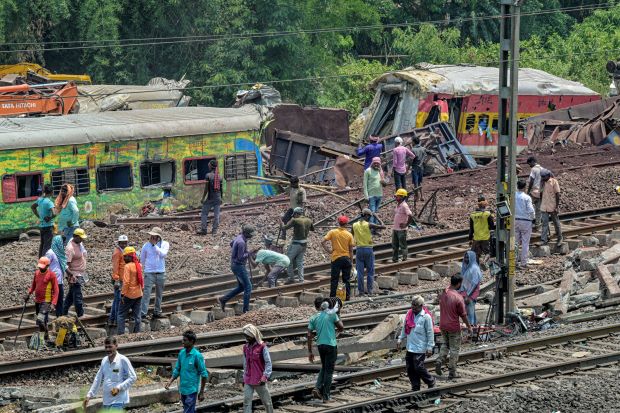Money for show horses, not work horses, on India’s rails
By Alex Travelli
NEW DELHI — In a country where major industry and political fortunes alike are often tied to a vast, interwoven rail system, India has lavished public resources on new trains, but its purse strings have been much tighter when it comes to ensuring the safety of those already racing along its tracks.
Those decisions loomed large Sunday (4) in the aftermath of a devastating train wreck that killed at least 275 people in eastern India. Investigators said they were focused on the possibility that signal failure might have led to the three-train crash Friday (2), the worst rail wreck in the country in years.
The crash, which also injured more than 1,100 people, occurred when a passenger train heading south at about 80 mph toward the city of Chennai veered onto the wrong track and hit a parked freight train, authorities say. The first train’s derailed cars then ploughed into a second passenger train that was heading toward it, leaving a scene of carnage.
Over the past years, India has been polishing its long-ramshackle infrastructure as never before, and its railways, which are at the heart of the world’s fifth-largest economy, have been a prime beneficiary. The government spent almost $30 billion on the rail system during the past fiscal year, up 15% from the year before.
But the amount spent on basic track maintenance and other safety measures has been falling. A report last year by India’s auditor general, an independent office, found that less money was being allocated for track renewal work and that officials had not even spent the full amount set aside.
With more than 20 million passengers riding the rails of India every day, many of them migrant workers, a politician cannot go wrong by showering money on the system, and Prime Minister Narendra Modi has done just that, with no little fanfare. The budget for the train system, one of the largest in the world, is five times as much this year than when he took office.
Most of Modi’s initiatives have been aimed not at the basic steps needed to get trains from Point A to Point B without mishap, but at improving speed and comfort. He regularly extols higher-fare new electric Vande Bharat trains connecting bigger cities and has made an early priority of a Japanese-style bullet train, though it can do nothing to improve the lives of the country’s ordinary passengers.
The government says the investment is part of an effort to elevate the experience of riding India’s railways to a world-class standard and to attract investment from abroad.
Spending on programs dedicated to safety improvements for India’s fleet of more than 13,000 older trains has been shrinking, however, as a portion of the total and even in absolute terms, according to the most recently published budgets.
Partha Mukhopadhyay, a senior fellow at the Centre for Policy Research, a organization in New Delhi, cited one need in particular. “The signalling function could perhaps do with more attention,” he said. “Strategically, signalling is a soft-capacity addition, and as we move to higher-speed trains, it will become more important.”
As devastating as the crash on Friday has been, rail travel in India is far safer than ever.
Derailments were once frequent, with an average of 475 per year from 1980 to about the turn of the century. In the decade leading to 2021, that number dropped to just over 50, according to a paper railway officials presented at the World Congress on Disaster Management.
Rail safety in India, more generally, has also improved, with the number of serious train accidents dropping steadily: to 22 in the 2020 fiscal year from more than 300 annually two decades ago. By 2020, for two years in a row, India had recorded no passenger deaths in rail accidents — a milestone hailed by the Modi government. Until 2017, more than 100 passengers were killed every year.
Under Modi, India has been on a spending spree, with its Finance Ministry and the World Bank hoping that private companies will follow the government’s lead and pour more money into the economy. The World Bank noted in a report in April that India’s rate of government spending toward long-term goals “has increased relative to the pre-pandemic level.” Transportation, including the railroads, plays a major part in that spending surge.
“In the 21st century, for rapid development of the country, growth and reform of railways is essential,” Modi said at the dedication of a train line last year. ”A nationwide campaign is underway to transform railways.”
Auguste Tano Kouamé, the World Bank’s country director for India, said the high rate of public spending on power distribution, new highways and the railroads would “crowd in” more spending by companies in pursuit of long-term gains.
Three months ago, intent on promoting homegrown safety technology, India’s railway minister, Ashwini Vaishnaw, made a show of placing himself and the chair of the Railway Board on two trains on a collision course. The idea was to demonstrate the new system, called Kavach, or armour.
The two trains sped toward each other on a single track. At a distance of 400 metres — about 440 yards — the new system applied the brakes automatically.
But the Kavach system has been installed on only a tiny fraction of India’s trains, covering about 900 miles of the total route, more than 40,000 miles. It was not used by the trains that crashed Friday, and one opposition politician, Mamata Banerjee, a former railway minister, seized on that.
“Had the device been on the train, this would not have happened,” she told reporters.
Vaishnaw, whose resignation has been demanded in some quarters — rejected the suggestion.
“This accident is not about the collision-avoidance system,” he said.
-New York Times



Comments are closed, but trackbacks and pingbacks are open.